When filling out a Location Release form, many individuals inadvertently make common mistakes that can lead to complications down the line. One frequent issue is overlooking the requirement for all necessary signatures. Every individual with ownership rights or interests in the property should provide their signature. Failing to obtain a signature can invalidate the release, causing potential legal disputes.
Another common mistake is not providing complete and accurate property descriptions. Clear and detailed information regarding the location ensures that all parties understand what property is being released for use. Incomplete descriptions may lead to confusion or disputes regarding which areas are included in the agreement.
Additionally, many forget to specify the intended use of the location. It’s essential to clearly state how the property will be used, whether for filming, photography, or another purpose. Without this clarity, property owners may later contest the use, leading to potential legal challenges.
Some individuals may also neglect to clarify the duration of the release. Whether it’s a single day or multiple months, specifying the timeline is crucial. A lack of clarity here can result in misunderstandings about how long the location will be utilized, which might cause friction between parties.
Another pitfall arises when individuals fail to read the entire document carefully. Often, important terms and conditions are buried in the fine print. Not taking the time to understand the entire form can lead to overlooking critical points that impact the release agreement.
In some cases, applicants may misinterpret local regulations affecting their usage rights. Different jurisdictions might have specific requirements regarding property releases, and assuming that all areas follow the same rules could lead to noncompliance issues.
Moreover, using outdated or incorrect information can pose significant problems. This includes contact information for the property owner or incorrect dates. Ensuring all information is current and accurate helps to prevent delays and misunderstandings.
Lastly, individuals often underestimate the importance of consulting with a legal professional. Seeking guidance can help clarify any areas of concern or uncertainty. Even a brief consultation can save time and money in the long run by avoiding potential legal pitfalls.
